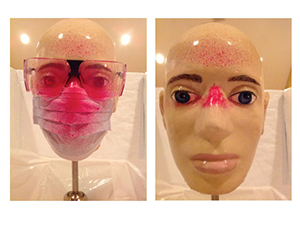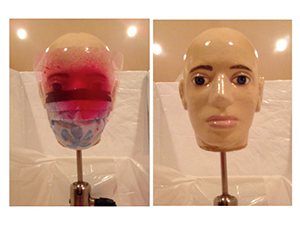
Eye safety is essential to dentistry. But the combination of most eyewear and dental masks does not fully protect the provider against projectile debris and spray. For instance, the space between the lower rim of the eyewear and the top edge of the dental mask exposes the provider’s eyes to potential risks. Now, 2 researchers are proposing an amendment to OSHA Standard 1910.133(a)(1) to eliminate this bottom gap.
“Research shows that approximately 48% of all dental providers suffer some sort of ocular trauma during their careers, said Peter Arsenault, DMD, head of the operative division and associate clinical professor in the department of prosthodontics and operative dentistry at the Tufts University School of Dental Medicine.
Handpieces rotating at 200,000 to 400,000 rpm can generate projectile debris from amalgam, enamel, calculus, pumice, broken burs, and other materials that can travel up to 50 mph. With the provider in the 12 o’clock position and the patient in the 6 o’clock position, an open gap can lead to variations of ocular trauma as well as HIV exposure and ocular herpes from blood and saliva (opening figure).
Dental professionals typically wear masks and protective eyewear in a variety of styles during procedures. While the eyewear has a bottom gap, most masks fail to provide a seal between their perimeter and the face, exposing the respiratory system to further danger. Though much less popular due to their costs, glare, fogging, and distortion, masks with a full-face transparent shield are much more effective.
“Masks with full-face shields attached or visors with long, downward projecting shields would be a good solution to close the bottom gaps and should be worn with ANSI Z87-compliant protective eyewear underneath,” said Arsenault, who considers the common combination of a mask and glasses with side shields unreasonably dangerous.
Arsenault independently worked with Amad Tayebi, ScD, professor emeritus of plastics engineering at the University of Massachusetts Lowell, to test how well different levels of eyewear protection and mask combinations stand up to projectile debris and spray. They began with a medium-sized mannequin head mounted and positioned to simulate the typical angle, position, and distance a dental professional would be relative to the patient and handpiece during a procedure.
 |
 |
|
Figure 1. Testing revealed how spray can enter the bottom gap left by typical protective eyewear and even reach the provider’s eye. |
Figure 2. A full-face shield completely protects the provider’s eyes from spray and debris, according to testing. |
While the mannequin’s head was wearing OSHA-compliant safety glasses with side shields and a standard flat-ear loop mask, the researchers sprayed it with a water-based red dye from the 4, 6, and 8 o’clock positions. According to the researchers, the glasses blocked debris along the frontal and side entry routes but still allowed spray through the bottom gaps (Figure 1).
Next, the researchers fitted the mannequin with a mask with a full-face shield but no eyewear and sprayed it again from the 4, 6, and 8 o’clock positions. The shield provided complete and adequate facial protection from the spray. As a result, Arsenault and Tayebi say that the current safety standard needs to be updated to eliminate the gap between the lower rims of the eyeglasses and the upper edge of the mask (Figure 2).
Furthermore, the researchers advocate the application of this improved standard of care to all dental personnel, including hygienists and assistants. They also suggest the use of this protection even when there isn’t any drilling, since scaling, polishing, and flossing could result in projectiles and splatter too. They even say that patients themselves should wear ANSI Z87-compliant glasses with side shields.
“The language in OSHA Standard 1910.133(a)(1) states that an employer must provide ‘appropriate’ eye protection. What defines ‘appropriate’ are the most current evidence-based research and best practices,” said Arsenault. “Current research names the bottom gaps as a possible entry route where debris can travel through that space towards the dental practitioner’s eyes.”
Employers who don’t provide protective gear that seals these bottom gaps are open to liability if an employee gets injured or sick as a result, the researchers warn. In some cases, they add, this negligence could be found reckless or intentional, entitling the employee to compensatory and punitive damages. To help protect employers, then, the researchers suggest amending OSHA Standard 1910.133(a)(1).
“For employees engaging in performing dental procedures, the employer shall ensure that each affected employee uses eye protection that provides protection from flying particles that may enter through the gaps between the lower rims of the lenses of the protective eyewear and the upper edge of the mask worn by the employee,” their amendment would say.
“Full-face shields, full goggles, bottom-gap-closing skirts attached to the lower rims of the lenses of the protective eyewear, and other commercially available means for closing said gaps meeting the pertinent requirements of this section are acceptable,” it would add.
Updating the standard would only be part of the battle, however. OSHA and other parties in the profession would need to educate dentists and their personnel about these changes. The researchers have presented their work to OSHA as well as members of the US House and Senate, the ADA Standards Administration Department, and the Commission on Dental Accreditation. Deans of dental schools have been apprised of their work as well.
“Dental schools play a role in educating dentists about safety standards and proper infection control practice as part of their early on, foundational education,” Arsenault said. “It is within the dental school where one develops habits that are typically carried throughout one’s career. With dental schools acting as role models to alumni and visiting dentists for continuing education, this would be another opportunity to reinforce or introduce best practices safety standards.”
Their study, “Eye Safety in Dentistry and Associated Liability,” was published by the Journal of the Massachusetts Dental Society.
Related Articles
OSHA Updates Eyewash Guidelines
Monitors Ensure Instruments Are Clean
Imaging Reveals Bur Debris Under Composite Fillings











